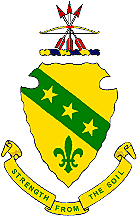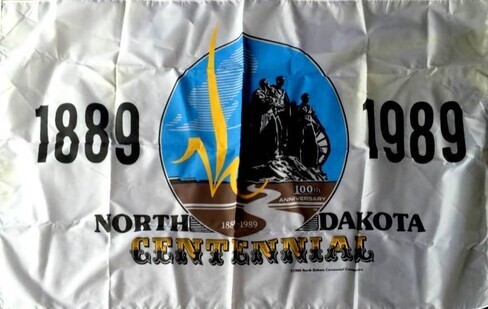![[Flag of North Dakota]](../images/u/us-nd.gif) image by Zachary Harden, 26 May 2016
image by Zachary Harden, 26 May 2016

Last modified: 2025-01-18 by rick wyatt
Keywords: north dakota | united states |
Links: FOTW homepage |
search |
disclaimer and copyright |
write us |
mirrors
![[Flag of North Dakota]](../images/u/us-nd.gif) image by Zachary Harden, 26 May 2016
image by Zachary Harden, 26 May 2016
See also:
In 1890, five stars were added, representing Idaho, Montana, North Dakota, South Dakota and Washington, bringing the total number of stars on the U.S. flag to 43. There were thirteen stripes representing the thirteen original colonies.
The North Dakota flag was adopted on March 3, 1911.
The legislation specifically required that the flag conform to the colors, form and size of the regimental flag carried by the North Dakota infantry in the Spanish-American war in 1898 and Philippine War in 1899 with the exception that the state name was placed on the scroll below the eagle.
Dov Gutterman, 9 October 1998
North Dakota Century Code 54-02-02.
State flag. The flag of North Dakota must consist of a field of blue silk or material which will withstand the elements four feet four inches [132.08 centimeters] on the pike and five feet six inches [167.64 centimeters] on the fly, with a border of knotted yellow fringe two and one-half inches [6.35 centimeters] wide. On each side of said flag in the center thereof, must be embroidered or stamped an eagle with outspread wings and with opened beak. The eagle must be three feet four inches [101.6 centimeters] from tip to tip of wing, and one foot ten inches [55.88 centimeters] from top of head
to bottom of olive branch hereinafter described. The left foot of the eagle shall grasp a sheaf of arrows, the right foot shall grasp an olive branch showing three red berries. On the breast of the eagle must be displayed a shield, the lower part showing seven red and six white stripes placed alternately. Through the open beak of the eagle must pass a scroll bearing the words "E Pluribus Unum". Beneath the eagle there must be a scroll on which must be borne the words "North Dakota". Over the scroll carried through the eagle's beak must be shown thirteen five-pointed stars, the whole device being surmounted by a sunburst. The flag must conform in all respects as to color, form, size, and device with the regimental flag carried by the First North Dakota Infantry in the Spanish American War and Philippine Insurrection, except in the words shown on the scroll below the eagle.
Joe McMillan, 19 February 2000
The recommended color of the flag is Pantone 654C or 289C.
"Flagman", 24 January 2006
The pattern of scroll was that used on U.S. Army military colors at the time the flags were adopted.
Joe McMillan, 24 January 2006
I found a construction sheet for the colors of the North Dakota flag at history.nd.gov/pdf/ND-Flag-Colors-Handout-2011.pdf. It was created in 2011 from a joint effort by the State Historical Society of North Dakota and the North Dakota Secretary of State. It confirms that the flag has a field that is Pantone 654 C and gives 13 other colors to be used on the flag, of which 11 are put into Pantone. This page is linked from history.nd.gov/state-flag.html, which also includes a new image of the flag, along with a close up of the arms. The only major difference is that the text is now officially blue instead of white. Another difference is that the arrows are each different colors (mostly at the arrowheads).
Zachary Harden, 24 March 2012
While searching for the "other" state flag of North Dakota described in Smith's Flag Book of the United States. I subsequently found the description in Chapter 54-41 of the North Dakota Century Code, relating to the North Dakota Coat of Arms:
54-41-01. Designation of coat of arms. A coat of arms of the state of North Dakota is designated and described as follows:
Device: On an Indian arrowhead point to base or a bend vert charged with three mullets of the first,
in base a fleur-de-lis of the second.
Crest: On a wreath or and azure, a sheaf of three arrows argent armed and flighted gules behind a
stringed bow fessways or with grip of the second (gules).
Motto: Strength from the soil.
54-41-02. Significant elements of coat of arms. The colors of yellow gold and green are indicative of the great agricultural state of North Dakota and has particular reference to ripening grain and the abundant grazing areas. The Indian arrowhead forms the shield of the coat of arms and symbolizes the "Sioux State". The three stars denote the trinity of government: legislative, executive, and judicial. Each star in the bend is given the heraldic value of thirteen which signifies the thirteen original colonies of the United States, and the cumulative numerical value of the three stars
indicates that North Dakota was the thirty-ninth state admitted to the Union. The stars also allude to the history of the territory under three foreign flags. Three stars are borne upon the coat of arms of Meriwether Lewis of the Lewis and Clark expedition and also on the coat of arms of Lord Selkirk, head of the first permanent settlement in this state. The
fleur-de-lis alludes to LaVerendrye, a French explorer who was the first known white man to visit the territory of this state. The blue and gold wreath in the crest reflects the history of the territory as part of the Louisiana purchase. The crest which shall constitute the military crest of the state of North Dakota is a motif taken from the state seal and to the Sioux Indian tribes signifies mighty warriors.
54-41-03. Authorized use. The coat of arms of this state may be used in a manner consistent with the respect and dignity due a state coat of arms and its symbolic values by the following persons, organizations, and agencies:
1. The governor of North Dakota.
2. The North Dakota national guard.
3. Departments and agencies of the state of North Dakota.
4. North Dakota veterans organizations.
5. Officially recognized North Dakota educational institutions, systems, or divisions thereof.
6. Recognized North Dakota patriotic organizations.
54-41-04. Employment as motif for color or standard - Use by governor. When the coat of arms is employed as the motif of a pennant, color, or standard it must be superimposed upon a pennant of green, as identified by cable number 65007, in the center one-third horizontally, and the center two- thirds vertically. The motif must in the main be golden yellow as identified by cable number 65001. The pennant must be fringed by the same golden yellow as the coat of arms. The color cable numbers must be the same as are on file in the office of the quartermaster general of the army, Washington, D.C.
The proportion of the pennant, color, or standard must be as 1 width hoist is to 1.9 fly. When used by the governor the coat of arms upon any pennant, standard, or placard must have a white star embroidered or emblazoned on each of the four corners of the pennant, standard, or placard.
Joe McMillan, 22 February 2000
![[Flag of Governor of North Dakota]](../images/u/us-ndgov.gif) image by Joe McMillan, 25 February 2000
image by Joe McMillan, 25 February 2000
Adopted 1957. Green with the North Dakota coat of arms on the center, the motto "Strength from the soil" on a golden yellow scroll beneath, and a white star in each corner. The flag is surrounded on three sides with golden yellow fringe. A Sioux Indian arrowhead is used as the escutcheon for the coat of arms. Dimensions are 1:1.9. The authorizing legislation also provides for a pennant. (North Dakota Century Code 54-41-04).
Joe McMillan, 25 February 2000
North Dakota's state flag is based on the design of late 19th century U.S. regimental colors, specifically that of North Dakota troops that fought in the Spanish-American War, as I recall, not on the state seal. There is also a second state flag, not widely used, that is green with the yellow-and-green state coat of arms which is also different from the seal.
Joe McMillan, 5 February 2001
 image by Joe McMillan, 9 February 2006
image by Joe McMillan, 9 February 2006
Based on a visit to the U.S. Army Institute of Heraldry some months ago, I can now offer additional information on the arms. According to Whitney Smith's Flag Book of the United States, in the 1950s the North Dakota National Guard became concerned that it was inappropriate for the state to continue using a state flag based on a military regimental color and approached the heraldic services division of the office of the Quartermaster General (now the Institute of Heraldry) to design a new state emblem that could be used for a new flag. In response, the QMG wrote to Major General Heber Edwards, the North Dakota Adjutant General, on January 30, 1957, as follows (quoting from the copy of the letter in the TIOH files):
In reference to your visit ... enclosed is a suggested design of a device for the State of North Dakota. The blazonry and description are as follows:By the way, I think the Heraldic Services Division was mistaken about Meriwether Lewis's arms, which I believe were "Argent a dragon's head erased at the neck Vert holding in its mouth a bloody hand proper." That is according to Crozier's Virginia Heraldica and other sources.
DEVICE: On an Indian arrowhead point to base or a bend vert charged with three mullets of the first, in base a fleur-de-lis of the second.
CREST: On a wreath or and azure, a sheaf of three arrows argent armed and flighted gules behind a stringed bow fessways or with grip of the second (gules).
MOTTO: Strength From The Soil.
The colors yellow and green are indicative of the great agricultural state with particular reference to wheat, the principal grain, and the abundant grazing area. The Indian arrowhead symbolizes the "Sioux State". The three stars denote the three branches of the state government: executive, legislative, and judicial. They also allude to the history of the territory under three flags. Stars are borne upon the coat of arms of Meriwether Lewis of the Lewis and Clark expedition and Lord Selkirk, head of the first permanent colony. The fleur-de-lis represents the French influence and the history of the territory as part of the Louisiana Purchase.
(signed)
ALFRED B. DENNISTON
Major General, USA
Acting The Quartermaster General "
 image located by
Ethan Dubrow, 23 December 2024The flag was made by the 1985 North
Dakota Centennial Commission, so maybe it was made a couple years before its
centennial.
image located by
Ethan Dubrow, 23 December 2024The flag was made by the 1985 North
Dakota Centennial Commission, so maybe it was made a couple years before its
centennial.
ndmil.gif) image by Joe McMillan, 21 April 2000
image by Joe McMillan, 21 April 2000
The state military crest, which is the crest used in the coats of arms of units of the National Guard, as granted by the precursor organizations of what is now the Army Institute of Heraldry. The official Institute of Heraldry blazon is
"A sheaf of three arrows argent, armed and flighted gules, behind a stringed bow fessways or with grip of the second."
Joe McMillan, 21 April 2000
The website at www.state.sd.us/state/capitol/capitol/tour/flags.htm alludes to a Dakota Territory flag. As far as I could understand from various sources, the flag was blue with the US coat of arms (of that era) on it. It seems very similar to current North Dakota flag.
Valentin Poposki, 26 September 2009
According to the South Dakota Magazine, territories did not have their own flags. They flew the U.S. Flag only. They did have official seals and that of the Dakota Territory is now used on the North Dakota flag. The Magazine is not 100% sure that they are right.
Steve Shumaker, 28 September 2009